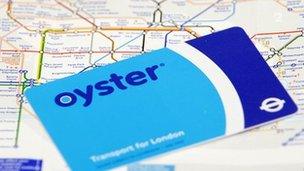London's Oyster travel smartcard turns 10
- Published

More than 60 million Oyster cards have been issued since 2003
It has been 10 years since London commuters began using travel smartcards - Oyster cards.
The cards were launched on 30 June 2003 and since then 60 million cards have been issued to commuters as well as visitors to the capital.
More than 85% of all rail and bus travel is paid for by the pay-as-you-go cards, Transport for London said.
Watchdog London TravelWatch said many Oyster card users still did not know how to get value for money.
In 2005 a daily price cap was introduced on the cards and in 2010 Oyster was rolled out to all rail services within Greater London.
The names Gem and Pulse were considered for the smartcard in addition to Oyster.
'Information gaps'
Commemorative cards have marked landmark events in the capital such as the London Olympics, the wedding of the Duke and Duchess of Cambridge in 2011, the Queen's Diamond Jubilee and the 150-year anniversary of London Underground.
The touch cards have also speeded the passenger's passage through the ticket barriers, with 40 people a minute going through the barriers compared to 25 with paper tickets.
A spokesman for London TravelWatch said: "Oyster has revolutionised the journey experience for Londoners and the decision to extend Oyster Pay As You Go (PAYG) to rail three years ago was a big step towards achieving the integrated transport network London needs and deserves.
"However, our incomplete journeys research in 2011 identified that some passengers have big knowledge and information gaps about how to get value for money with Oyster PAYG, and how to claim refunds.
"There are also other stations such as Epsom where passengers would benefit from an extension of the Oyster scheme."